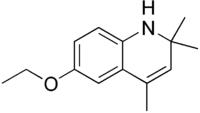| Revision as of 12:45, 22 February 2011 editBeetstra (talk | contribs)Edit filter managers, Administrators172,081 edits Script assisted update of identifiers from ChemSpider, CommonChemistry and FDA for the Chem/Drugbox validation project - Updated: ChEMBL.← Previous edit | Revision as of 12:56, 22 February 2011 edit undoCheMoBot (talk | contribs)Bots141,565 edits Updating {{chembox}} (no changed fields - added verified revid - updated 'ChEMBL_Ref', 'KEGG_Ref') per Chem/Drugbox validation (report errors or [[user taNext edit → | ||
| Line 1: | Line 1: | ||
| {{chembox | {{chembox | ||
| | verifiedrevid = |
| verifiedrevid = 415311766 | ||
| | Reference=<ref>'']'', 11th Edition, '''3710'''</ref> | | Reference=<ref>'']'', 11th Edition, '''3710'''</ref> | ||
| | Name = Ethoxyquin | | Name = Ethoxyquin | ||
| Line 15: | Line 15: | ||
| | InChI = 1/C14H19NO/c1-5-16-11-6-7-13-12(8-11)10(2)9-14(3,4)15-13/h6-9,15H,5H2,1-4H3 | | InChI = 1/C14H19NO/c1-5-16-11-6-7-13-12(8-11)10(2)9-14(3,4)15-13/h6-9,15H,5H2,1-4H3 | ||
| | InChIKey = DECIPOUIJURFOJ-UHFFFAOYAT | | InChIKey = DECIPOUIJURFOJ-UHFFFAOYAT | ||
| | ChEMBL_Ref = {{ebicite|correct|EBI}} | |||
| | ChEMBL = 172064 | | ChEMBL = 172064 | ||
| | StdInChI_Ref = {{stdinchicite|correct|chemspider}} | | StdInChI_Ref = {{stdinchicite|correct|chemspider}} | ||
Revision as of 12:56, 22 February 2011
 | |
| Names | |
|---|---|
| IUPAC name 6-ethoxy-2,2,4-trimethyl-1,2-dihydroquinoline | |
| Identifiers | |
| CAS Number | |
| 3D model (JSmol) | |
| ChEMBL | |
| ChemSpider | |
| ECHA InfoCard | 100.001.887 |
| E number | E324 (antioxidants, ...) |
| PubChem CID | |
| UNII | |
| CompTox Dashboard (EPA) | |
InChI
| |
SMILES
| |
| Properties | |
| Chemical formula | C14H19NO |
| Molar mass | 217.31 g/mol |
| Melting point | < 25 °C |
| Boiling point | 123–125 °C at 2 mmHg |
| Except where otherwise noted, data are given for materials in their standard state (at 25 °C , 100 kPa).
| |
Ethoxyquin is a quinoline-based antioxidant used as a food preservative (E324) and a pesticide (under commercial names such as "Stop-Scald"). It is commonly used as a preservative in pet foods to prevent the rancidification of fats. There has been some speculation that ethoxyquin in pet foods might be responsible for multiple health problems. To date, the U.S. Food and Drug Administration (FDA) has only found a verifiable connection between ethoxyquin and buildup of protoporphyrin IX in the liver, as well as elevations in liver-related enzymes in some animals, but there are no known health consequences from these effects. Until further evidence is reported, the FDA has asked pet food manufacturers to voluntarily limit ethoxyquin levels to 75 ppm. However, most pet foods that contain ethoxyquin have never exceeded this amount.
Ethoxyquin has been shown to cause mortality in fish.
Ethoxyquin is also commonly used in spices to prevent color loss due to oxidation of the natural carotenoid pigments.
The FDA Center for Veterinary Medicine (CVM) in 1997 requested a voluntary reduction of ethoxyquin from 150 ppm to 75 ppm in complete dog foods. The work used to make the reduction request was never published in peer reviewed journals or made readily available to public or scientific scrutiny.
References
- Merck Index, 11th Edition, 3710
- ^ Pet Food Labels, U.S. Food and Drug Administration
- Ethoxyquin at the PAN pesticide database
http://www.petfoodindustry.com/ViewArticle.aspx?id=12892#Scene_1
Categories: